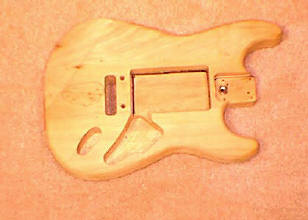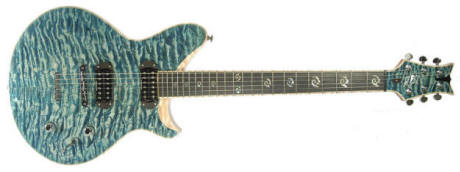Stratocaster
|
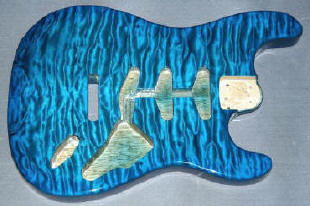
Typical Pearlcaster Body
Royal Blue Quilted Maple
|
ALL ACCESS NECK JOINT

I don't just dedicate my efforts to tonal improvements,
I also stress playability.
What good is a great sounding guitar if you can't
play it easily.
The Koa model above & below left, is built in the traditional Fender
format.
The Korina model in the middle and the Flame Maple model on the right sport all access neck joint.
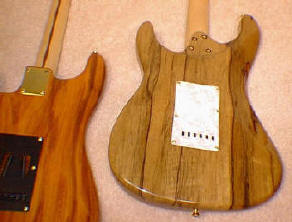

These 3 Stratocasters Have Been Improved a Number of Ways
See Below
| Tonally: 1995 | By using high quality highly resonant tone wood |
| Tonally: 1995 | By adhering to the original pickup cavity configuration. |
| Tonally: 1995 | By total elimination of glues & fillers |
| Tonally: 1995 | By the addition of higher quality better sounding pickups |
| Tonally: 2005 | By offering Brazilian Rosewood or Ebony Fretboards (plus others) |
| Tonally: 2006 | By attaching neck to body with Ed Roman's exclusive brass inserts |
| Tonally: 2007 | By offering titanium Bridge saddles as an option. |
| Tonally: 2008 | By offering Gold Tone Adamantium frets. An Ed Roman exclusive |
| Tonally: 2008 | We are now offering Nitrocellulose paintjobs. |
| Tonally: 2008 | By offering "Stellar Tone" Circuitry, "Bullet" preamps & a host of electronics |
| Playability: | The "All Access Neck Joint" TM |
| Playability: | The original Fender necks are all custom re shaped to the player's hand |
| Playability: | 1500 G modification |
| Playability: | The tremolo system can be replaced with virtually any brand |
| Playability: | We offer the Buzz Feiten System in all of our guitars and conversions |
| Playability: | Frets are all redressed and highly polished |
| Cosmetically: | The finishes are beautiful |
| Cosmetically: | The color choices are limited only by your imagination |
| Cosmetically: | Every single screw is replaced with high quality gold plated ones |
| Cosmetically: | Pick guards are replaced with higher quality Latrinium or Wood |
| Cosmetically: 2007 | Now offering extremely high quality distressing and aging process |
|
Ed Roman's Brass Insert System For Better
Stability
It actually costs less to glue in a neck than to bolt one in
correctly. Gluing
up a neck is pretty basic. You apply glue inside the neck joint, slide the neck
in and clamp it down. A bolt in neck requires a lot more work, there is no room
for a sloppy fit like on a glue in neck. The cost of stainless bolts and press
fittings are far higher than the cost of a little glue. The labor factor
requires 4 holes drilled and countersunk. The tolerances are extremely tight on
a good bolt on neck where the tolerances are far less important with the
application of glue. If you make a mistake and drill incorrectly itís time to
throw away the body. On a glued up neck there are no holes to drill and less
chances of a mistake. I know, I know itís been done that way for 60 years! why change now? Why
not keep our heads buried in the sand & continue thinking like we did in the
50ís & 60ís ? Thanks to modern machinery and woodworking techniques neck joints are a lot
better & tighter today. We now know much more about guitar construction than we
used to. Guitars in general are a lot better today, even the Mexican ones are
better than some of those USA guitars from the 90ís. A tight neck joint equals a
good guitar !!!
|
.jpg)

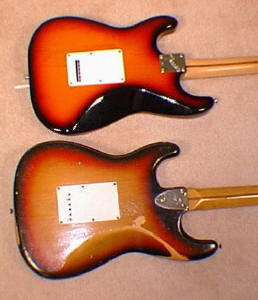 older 70's Strat. The
major difference between these two instruments is the material used in the basic
construction of the body.
older 70's Strat. The
major difference between these two instruments is the material used in the basic
construction of the body.